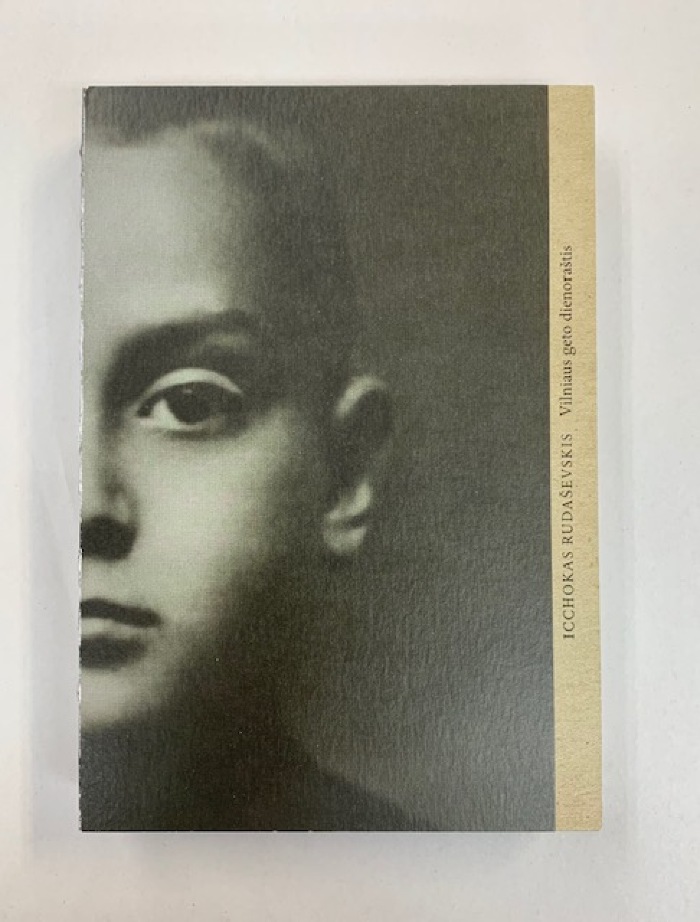Collections
Vilniaus geto dienorastis (Vilnius Ghetto Diary) / Yitzchak Rudashevski
Books
FA.B61.2044
5.7 x 8.3 in; 14.5 x 21 cm
2018
Reproduction of a diary found in the Vilnius ghetto during World War II. The diary belonged to Yitzchak Rudashevski, a 15-year-old Jewish boy. The work is published in the original Yiddish and translated into Lithuanian.
"Yitzchak Rudashevski was born in Vilnius in 10 XII 1927 -- his father, Eliyahu, worked in a publishing house, and his mother, Rosa, was a seamstress. In September 1941, when Yitzchak was not yet 14 years old, the Nazis forced the boy and his family into the Vilna Ghetto. At some point during the Nazi occupation, Yitzchak started writing a diary in Yiddish where he described the day to day horrors the Jewish population had to endure. In the main part of the diary, which encompasses the period from September 1942 to April 1943, the young man chronicled all aspects of the ghetto, using his literary talents to not only describe, but also to reflect with great clarity and insight for a 15 year-old upon what was happening within the walls of the houses and streets he had been confined to. As the author himself put it, 'I consider that everything must be recorded and noted down, even the most gory, because everything will be taken into account.' In the fall of 1943, as the Vilna Ghetto was being liquidated, the Rudashevskis managed to hide away in a secret shelter, but after only two weeks the Nazis discovered their hiding place and executed everyone. Only Sarah Voloshin, Yitzchak's cousin, managed to escape and flee to the forests surrounding Vilna. After the Soviets re-occupied the town in the summer of 1944, she returned to the shelter and found a small notebook, its more than 200 pages filled with handwriting, some in pen, and some in pencil. It was the diary of Yitzchak Rudashevski.
"About the cover: The cover has been replaced by the author's portrait cut into halves and stitched to the publication. It was not the yellow star but a child's tragic destiny that was sewed to the book. Everyone who takes the diary into his hands gains power to cover the boy's eyes and thus spare and deliver him from the horror awaiting him in the near future. Let us grant him and the others exposed to this nonhuman tragedy the opportunity to hide into the outstretched palms of the reader. Let us try hard to identify any chances of survival -- both within the characters portrayed and within our memory. Yitzchak Rudashevski strength, a feeling of sadness over the years wasted in the Ghetto and unshakable faith in life is symbolized by the unique opportunity presented to the reader, that is, by connecting the two halves of the portrait. Basically, it means trying to put together something that can no longer be reunited. On the spine of the book, the pages are sewn and the inscription of Yitzchak Rudashevski's name is printed. The font used in the book of the inscription is that of the 'Yiddishkeit Vilna', believed to have been used by Yitzchak's father Elijah who worked at the 'Vilner tog' as a typesetter. The book has been intentionally stripped naked, as a token of remembrance of those who were stripped naked and forced to march to the Paneriai forest to be murdered.
"About the pages of the book: There are two beginnings within the book and no end. On the left is the Lithuanian introduction by Dr. Mindaugas Kvietkauskas and the translation of the original text, on the right you will find an original text in the Yiddish language. Both texts intersect at the place where the facsimiles of the diary are published. At the beginning of the Lithuanian text, the authentic documents and documentary photographs are published. At the start of the Yiddish diary, photography is presented metaphorically, thus offering the reader a new vantage point. Among them, several photos from the Vilna ghetto hideouts have been inserted.The publication is bilingual and has a double numbering.
"Today, the original diary is kept at YIVO in New York (an institute established in Vilnius in the 1920s for the research of Yiddish) and copies of the diary are in other archives, including the archive at Yad Vashem, Jerusalem.
Translated and complied by Mindaugas Kvietkauskas
Designed by Sigute Chlebinskaite
Published by Lithuanian Jews Community
Printed by Standartų spaustuvė
Vilnius, Lithuania 2018" -- publisher's note
